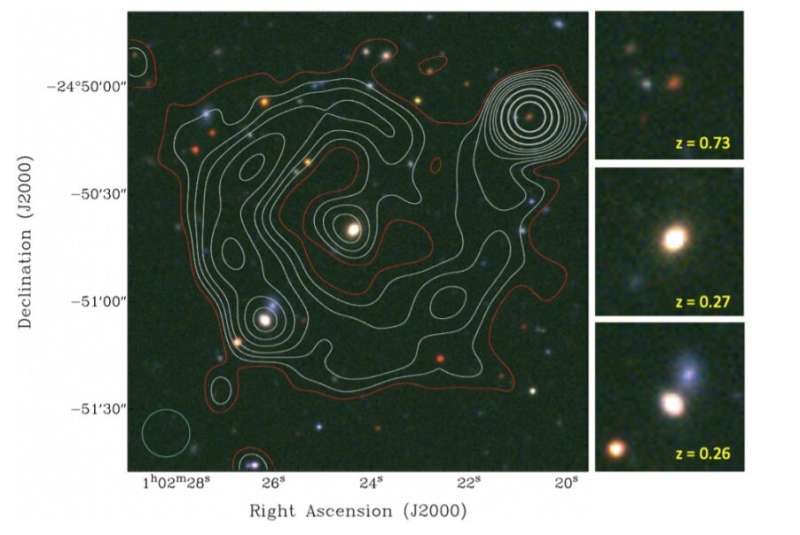Astronomers discover a new extragalactic circular radio source

Using the Australian Square Kilometre Array Pathfinder (ASKAP), astronomers have detected a new extragalactic odd radio circle (ORC). The newfound radio source, designated ORC J0102–2450, has a diameter of nearly 1 million light years. The finding is reported in a paper published April 27 on arXiv.org.
Odd radio circles (ORCs) are very large mysterious objects that are highly circular and bright along the edges at radio wavelengths. Although ORCs are bright at radio wavelengths, they cannot be observed at visible, infrared or X-ray wavelengths. So far, only few objects of this type have been identified, hence very little is known about their origin and nature.
Now, a team of astronomers led by Bärbel S. Koribalski of the Australia Telescope National Facility reports the newest addition to the short list of known odd radio circles—ORC J0102–2450. The discovery was made as part of the search for ORCs and other extended radio sources in a deep (about 40 deg2) ASKAP field centred near the starburst galaxy NGC 253.
“We present the discovery of another odd radio circle (ORC) with the Australian Square Kilometre Array Pathfinder (ASKAP) at 944 MHz,” the researchers wrote in the paper.
The newly detected ORC has a radio ring diameter of around 70 arcseconds, or 978,000 light years. The source’s total radio flux was measured to be some 3.9 mJy, while its total radio luminosity was found to be approximately 140 billion TW/Hz. The object is most likely associated with the central elliptical galaxy DES J010224.33–245039.5.
Taking into account the overall radio morphology of ORC J0102–2450 and non-detection of ring emission at non-radio wavelengths, the astronomers draw some conclusions regarding the origin of this ORC. They suppose that it could be a relic lobe of a giant radio galaxy seen end-on or a giant blast wave, possibly from a binary supermassive black hole merger, resulting in a radio ring of such large size. A third scenario considered by the authors of the paper is that it could be a radio galaxy and intergalactic medium (IGM) interactions.
However, the researchers added that more discoveries of ORCs with ASKAP and other telescopes are needed in order to verify the proposed hypotheses.
“We encourage the search for further ORCs in radio surveys to study their properties and origin (…) Low-frequency LOFAR surveys at high-resolution (6”) will be of particular interest (see Shimwell et al. 2019), given the steep spectral index of known ORCs. Deep X-ray observations may also detect these energetic events as shown in the case of a giant relic radio galaxy by Tamhane et al. (2015),” the paper reads.
Summing up the results, the astronomers noted that ORC J0102–2450 with ASKAP makes it the third odd radio circle with an elliptical galaxy at its geometrical center. They assume that it is not a coincidence and ORCs with such galaxies may be common, what could help us better understand formation mechanisms of these sources.


 Creators of mankind
Creators of mankind Description of “Tall white aliens”
Description of “Tall white aliens” Where they came from?
Where they came from? About hostile civilizations
About hostile civilizations The war for the Earth
The war for the Earth “Tall white aliens” about eternal life
“Tall white aliens” about eternal life Video: “Nordic aliens”
Video: “Nordic aliens” Aliens
Aliens Alien encounters
Alien encounters The aliens base
The aliens base UFO
UFO Technology UFO
Technology UFO Underground civilization
Underground civilization Ancient alien artifacts
Ancient alien artifacts Military and UFO
Military and UFO Mysteries and hypotheses
Mysteries and hypotheses Scientific facts
Scientific facts


















